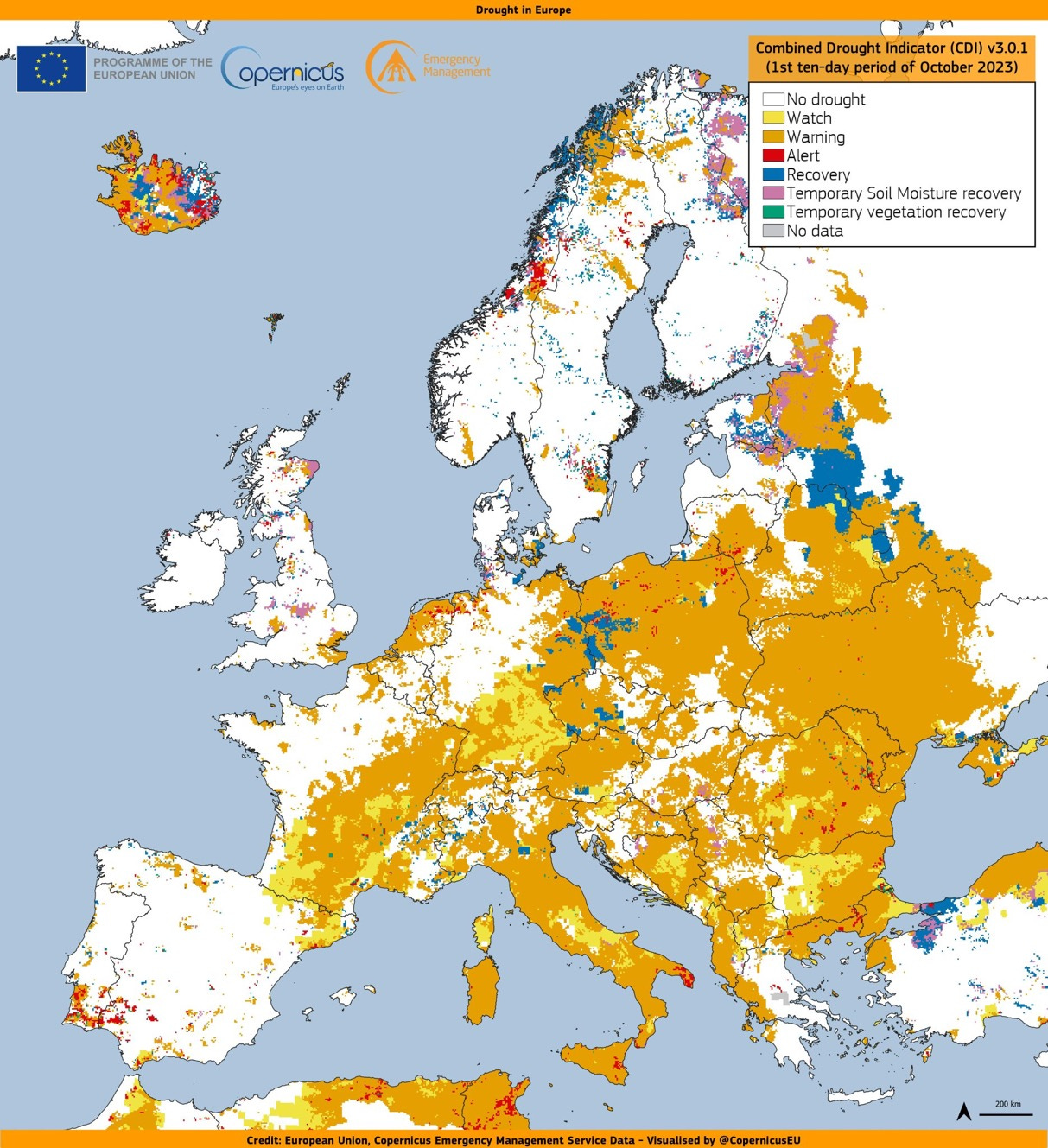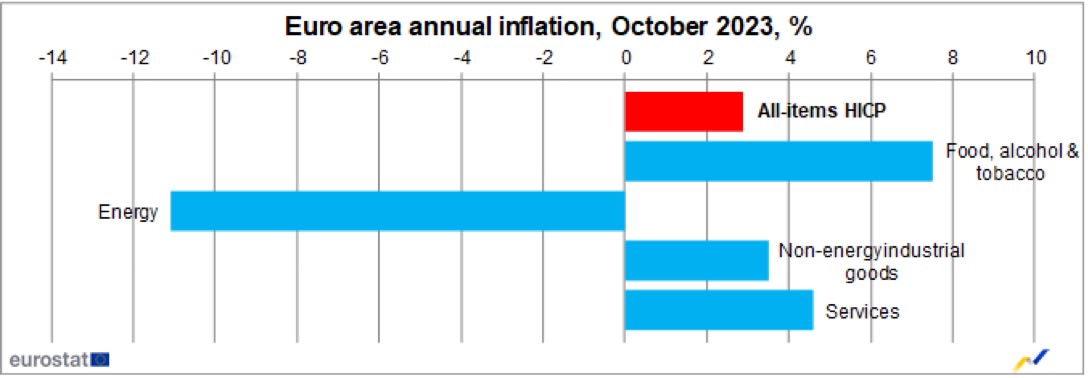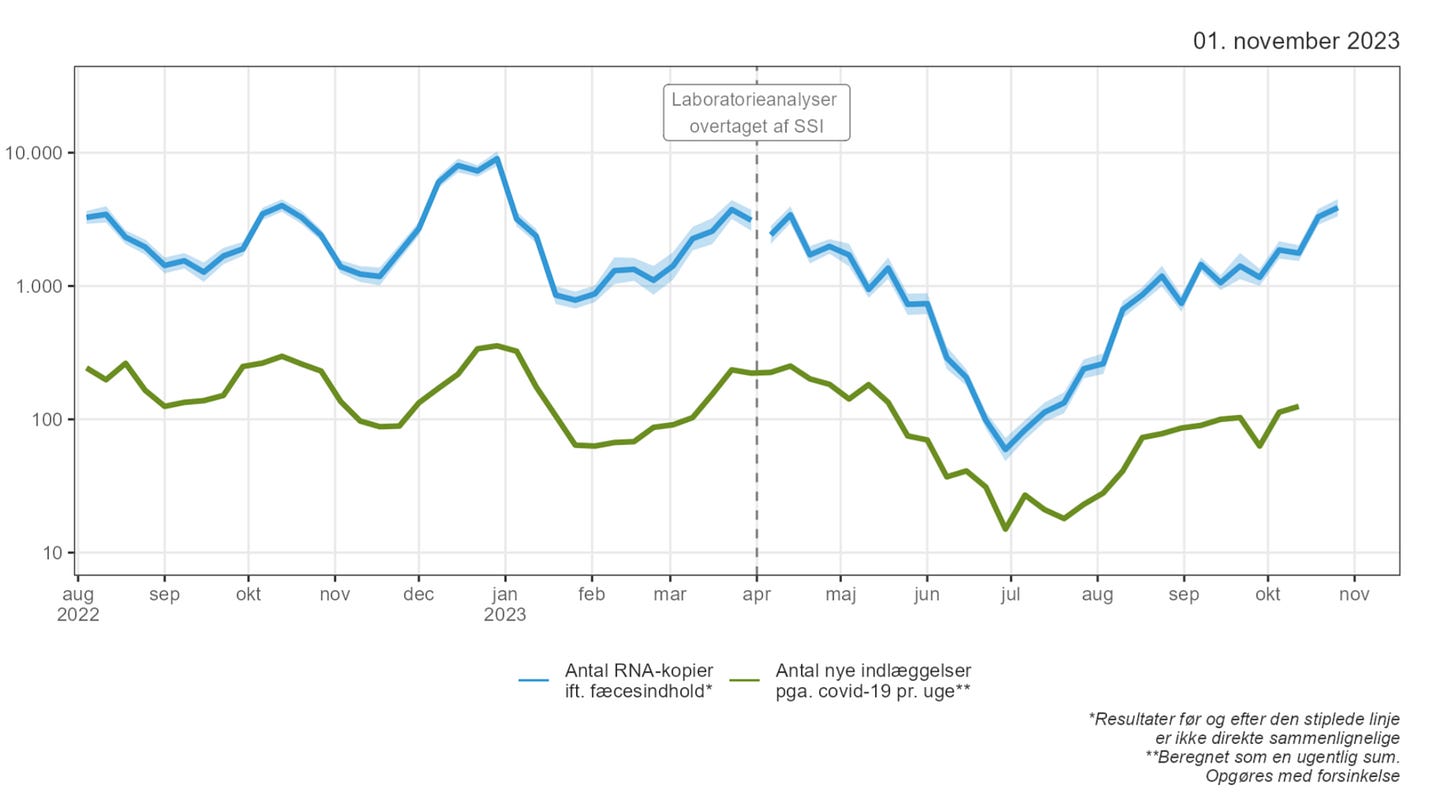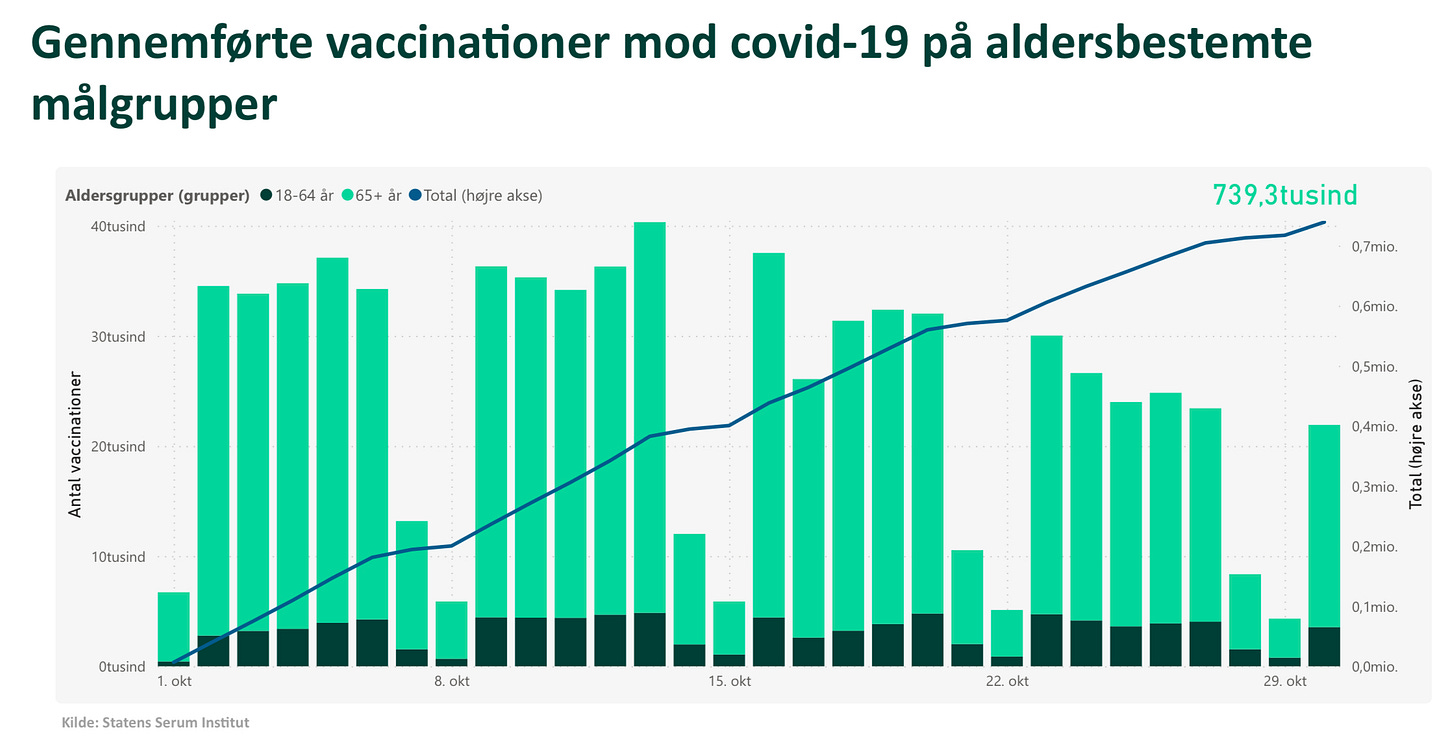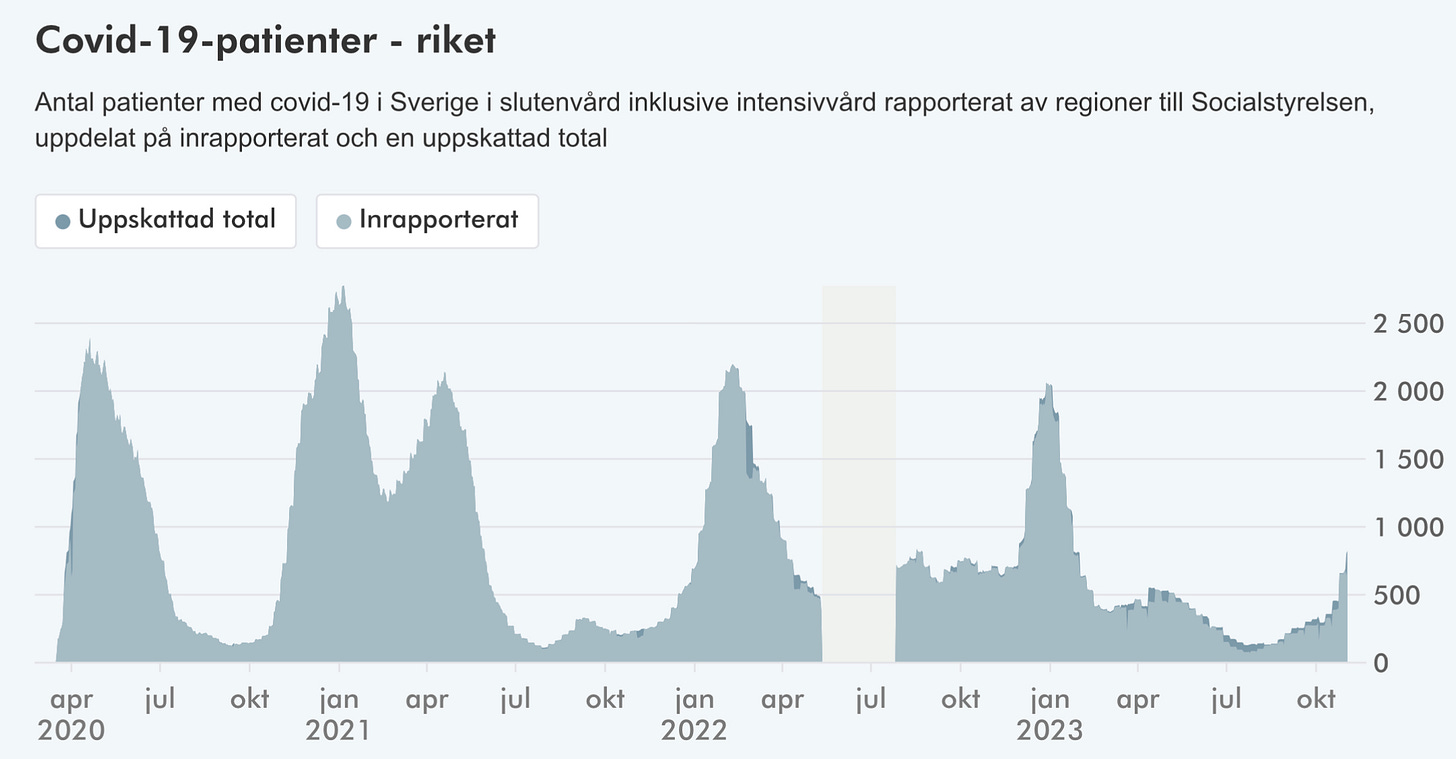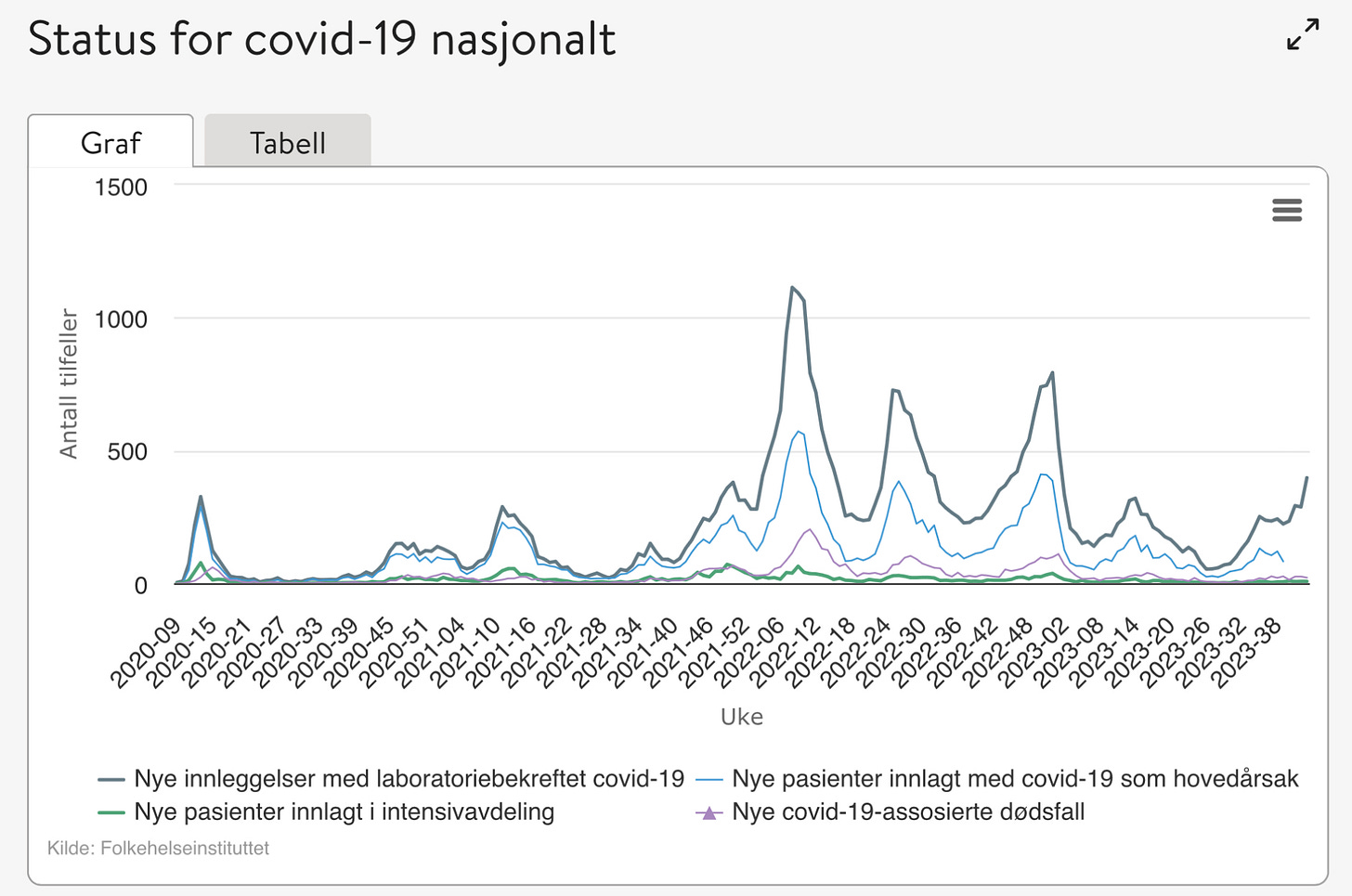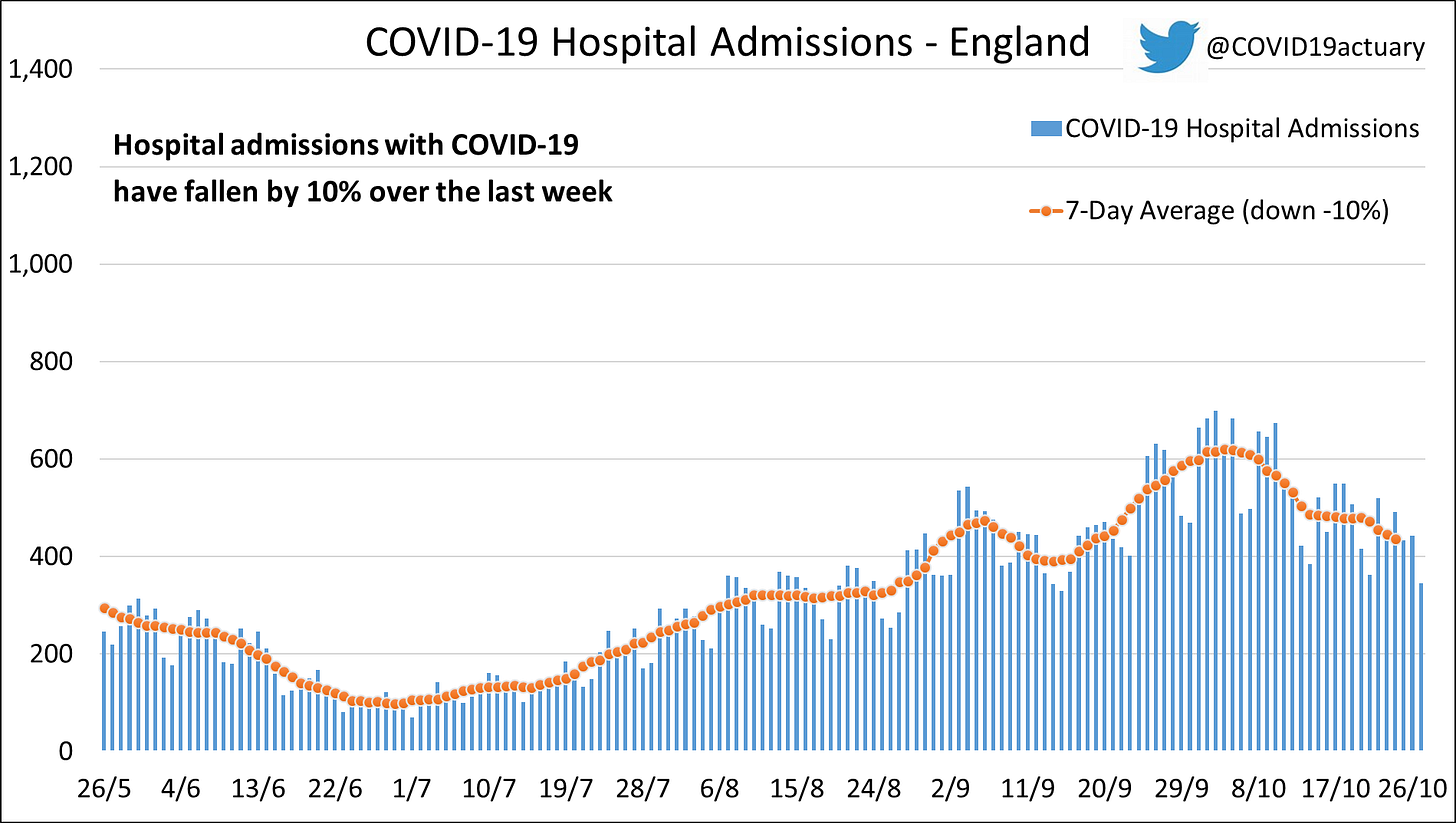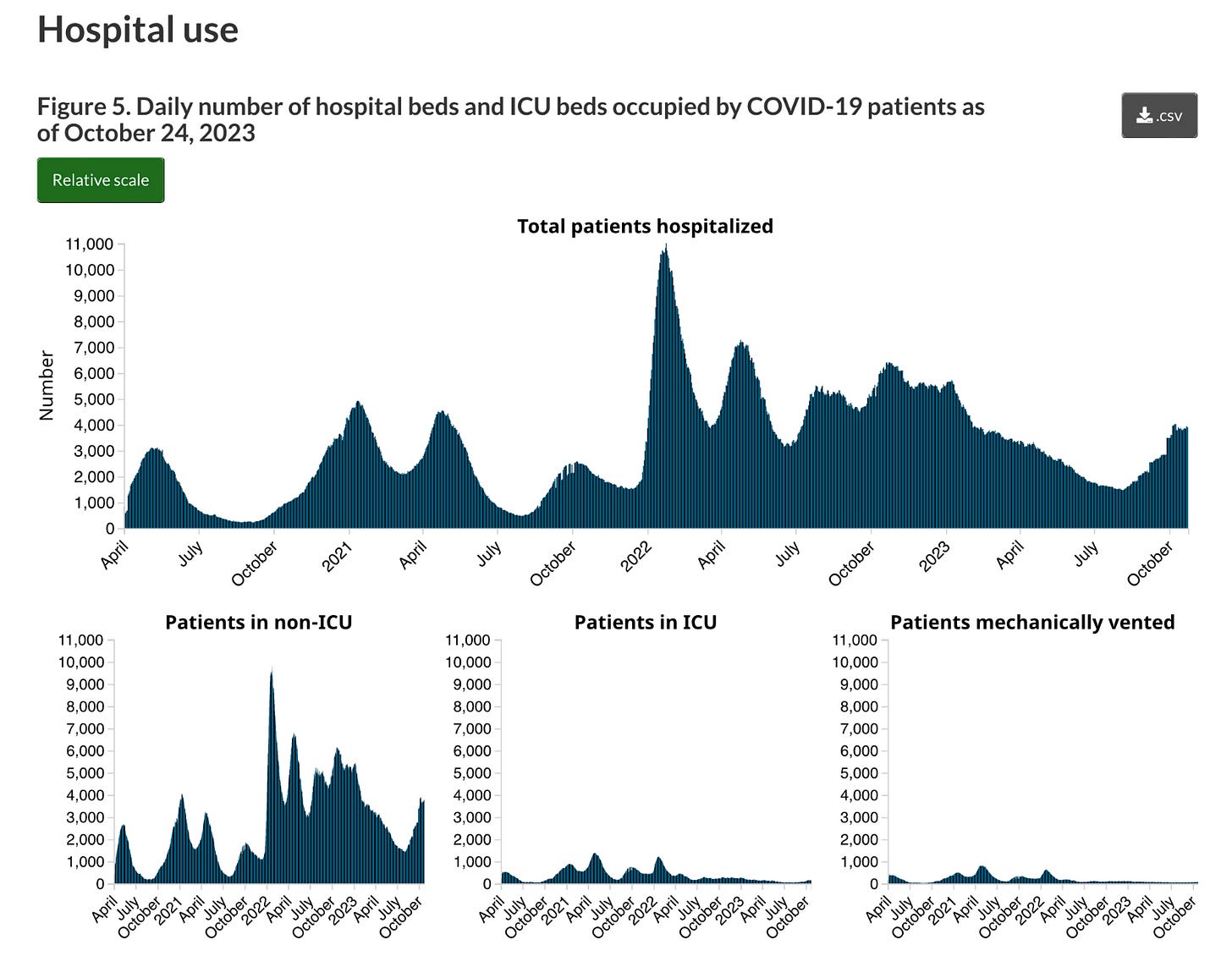The Evening Report - Nov 2
Labour shortage hinders green transition. COVID hospitalizations surge in Sweden.
🍃Environment & Energy⚡️
🇮🇪 🇬🇧 🇫🇷 ☔️
Storm Ciarán has buffeted Ireland, England, and France with hurricane-force winds churning up ocean waters, knocking out power, and claiming at least two lives. Over a million homes were without power in France as of Thursday morning. The storm is whipping up winds in the 152-kilometer range and is expected to blast through France, Portugal, and Spain, along with other areas in central and southern Europe.
So far, meteorologists have not issued any storm warnings among the Nordic countries.
🇩🇰
Denmark’s green transition is facing a significant labour challenge. According to Green Power Denmark, one out of every six green energy sector companies has moved production out of Denmark because of a lack of skilled labour. At the moment there are about 70,000 workers in the sector, which is about 45,000 fewer than what is actually needed.
Green Power Denmark says with the green transition intensifying 77% of the companies working in this new industry must increase their workforce. Of those, 42% say their ability to find skilled workers in Denmark is “very bad.”
Deputy CEO Jan Hylleberg:
“It is a very worrying situation. We have to use all the tools we have in the toolbox to ensure that companies can hire the employees they need. Our climate action is deeply dependent on having employees who can carry out the work.”
The green energy transition is essentially building an entirely new industry one that is dependent on building out many kilometers worth of electric cables, hydrogen, and heating pipes. This is on top of adding more wind turbines and solar panel farms. More electricians, blacksmiths, industrial technicians, engineers, and IT specialists are needed to get this work done.
“Immediate action is needed to solve these acute challenges, and at the same time, we must start making plans for the future. Several companies are currently finding it difficult to find employees with the skills they need. And when we look ahead, the challenges will only get worse unless something changes.”
Green Power Denmark is recommending that the government form a partnership among government ministries and industry experts to establish and implement an action plan to address the labour shortage. It also wants to increase intake for technical and vocational training programs to create more local skilled labour. But even then GPD says more seniors will have to remain in the labour market, more women are needed, and skilled labourers from abroad will have to be recruited to come to Denmark to meet the demand.
“It must be easier to hire and retain international employees with the skills that companies demand. Regardless of how we twist and turn it, we will need to bring in skilled labourers into Europe if we are to get enough employees to carry out the green transition.”
-
The clean-up from last month’s major flooding along Denmark’s East coast continues. In some cases where sewage has mixed with flood waters emergency workers who have been in contact with it have had to be vaccinated against hepatitis and other diseases. So far, about 100 Fire and Rescue staff in Sønderjylland and Beredskab Sønderborg in Southern Jutland have been offered the vaccines, which have to be administered within eight days of any potential exposure.
-
Denmark is on track to record the wettest year ever. According to the Danish Weather Institute (DMI) 776.6 millimeters of rain has fallen across the country up until October. All that is needed to set a new annual rainfall record is for November and December to log-normal amounts of precipitation, about 142 millimeters between the two months. Denmark saw a record 905 millimeters of rain in 1999. The country has been keeping rainfall statistics since 1874.
-
According to Green Power Denmark energy from wind and solar covered 75% of Denmark’s total power consumption last month. An extremely windy October helped to produce a windfall of energy for Danish households.
-
Since October 1, it has been illegal for some diesel cars to drive in environmental zones set up in the center of Copenhagen, Aarhus, Odense, Aalborg, and Frederiksberg. And it looks like quite a few motorists haven’t been paying attention to the new rules. So far 3,045 tickets have been issued at 1,500 Danish kroner a pop (about $294 Cdn). Over half of those tickets have been issued in Metro Copenhagen. The new rules specify that certain types of diesel vehicles without an approved particle filter are no longer allowed to drive in the new environmental zones. Enforcement is done via camera with tickets sent by mail.
🇪🇺
While Denmark is on track for the wettest year ever the exact opposite story is playing out elsewhere in Europe. According to the EU Copernicus Climate Change Service drought conditions persist across a swath of the continent. The Copernicus EU Drought Observatory 36% of the European Union is in a drought ‘warning’ condition.
🇸🇪
The cleanup is ongoing after an oil spill along a section of the Swedish coast near Karlskrona. Swedish national broadcaster SVT is reporting that hundreds of birds that were caught in the oil and diesel spill could die. Right now volunteers are working hard to clean up rescued birds so they can be saved but the work is challenging. A ferry named Marco Polo is to blame for the oil spill after it became grounded not once but twice while sailing from Trelleborg to Karlshamn on October 22. It leaked oil and diesel along the Swedish coast during the three nautical miles from the first collision to the second.
🇩🇰 🇪🇺
The wind energy woes mount at Danish energy giant Ørsted. The company is ending its Ocean Wind 1 and 2 offshore wind energy projects in the United States. In August the company also declared losses on its Sunrise Wind and Revolution Wind projects. All this has resulted in Ørsted writing down 28.4 billion Danish kroner in losses (about $5.5 billion Cdn) in the first nine months of 2023 according to the company’s interim financial report filed on Wednesday. The company blames the write-downs on rising interest rates and delays along its supply chain.
Sydbank Equity Analysis Head Jacob Petersen told DR that the write-downs are “gigantic.”
“This may mean that the ambitions to build wind turbines in the future are throttled because the financial belts cannot support that growth.”
Ørsted shares dropped like a rock after the news of its first big write down and its stocks took another beating with this latest news. Shares fell by another 25% calling off the company’s worst trading day ever. The main shareholder in the company is the government of Denmark, which owns 50.1% of the shares.
This is another wrinkle in a fiscal crisis that is rolling across the European wind energy sector at a time when the EU is leaning heavily on increasing offshore wind power for its green energy transition goals.
🇫🇮
Forum, a Finnish state-owned energy company, has announced it is strumming it’s looking to make around €100 million in cuts. The move could mean some job losses. In a press release sent out on Thursday, the company says the current business climate is “challenging” and the situation is being exacerbated by “general economic conditions.” With that in mind, it is looking to cut costs by €100 million by the end of 2025. The company also warned that the cuts "will also include personnel reductions".
🇪🇺
Mixed financial news for the Eurozone. On one hand inflation keeps falling. A preliminary forecast from the European Union’s statistics agency EuroStat has inflation in Europe falling from 4.3% in September to 2.9% in October. On the other hand, economic growth in the Eurozone contracted in the third quarter due in part to the European Central Bank increasing interest rates and Germany’s huge economy edging closer to a recession.
🦠COVID🦠
🇩🇰
COVID activity (blue line) and infection-relate hospital admissions (green line) continue to rise across Denmark. The Statens Serum Institute says that COVID wastewater surveillance shows a “very strong increase” in coronavirus activity over the last three weeks.
-
One month into Denmark’s fall/winter vaccination campaign about 1.71 million vaccine doses have been administered. According to the Danish National Health Authority, 52.6% of seniors over 65 have had a COVID booster. But the influenza vaccine seems more popular this year with 56.5% of seniors getting vaccinated against influenza so far. Among children, two to six years old 27,000 (8.1%) have had a special pediatric influenza nasal vaccine.
Acting Unit Head and Chief Physician Kirstine Moll Harboe:
"It is very satisfying to see that both the booking of appointments and vaccinations have gone well. We have a very good vaccination program which helps people at increased risk get through the autumn and winter.”
Harboe expects vaccinations to cross the two million doses administered threshold by next week.
The health authority is urging everyone who is eligible to get their vaccinations before the big family holiday get-togethers.
"We can see that a lot of people who want to get vaccinated have booked a vaccination appointment over the next few weeks. We encourage all citizens over the age of 65 and persons at high risk to be vaccinated before Christmas.”
-
Denmark’s healthcare system continues to struggle with too little funding, not enough beds, and a lack of staff. The healthcare system has been staggering from one crisis to another after years of being battered by the COVID pandemic. The backlog of procedures was made even worse when nurses launched a serious and protracted strike in 2022. Despite multiple injections of billions of Danish kroner the system has been struggling to get back to an even footing.
North Jutland Regional Council Chair Lene Linnemann:
“We are already hard-pressed both here in North Jutland and also in the rest of the country, so the longer the government hesitates, the longer the waiting lists will be.”
For her part, Health Minister Sophie Løhde says a national priority council will be set up to ensure the most bang for every kroner spent on healthcare.
🇸🇪
“There is an insane amount of COVID out in society right now.”
The number of confirmed coronavirus infections across Sweden is beginning to climb. The Swedish Public Health Agency tabulated 1,286 COVID infections last week, up from the previous week’s 964. Due to the lack of testing, this is likely a fraction of the actual number of infections.
Region Norrbotten Infectious Disease Doctor Anders Nystedt who himself is sick and working from home spoke to the Swedish newspaper Aftonbladet
“Of those who have a cold and are tested, every third person has COVID. It is important that if you have cold symptoms you should stay at home if you can or at least keep your distance at work. There is an insane amount of COVID out in society right now. We are seeing quite a large increase. At the same time, there are relatively few who end up in hospital, but even so, there is still an extra burden on the healthcare system.”
COVID hospitalizations in Sweden (701) also continue to surge upward (+47) while the number of severely infected people needing intensive care (20) crept up (+2).
Sundsvall Hospital north of Stockholm recently had to go into emergency staffing mode because of the sheer number of incoming COVID patients.
Sweden’s State Epidemiologist Magnus Gisslén says it is older people who are very much in harm’s way right now.
“As it is right now, I have no screaming anxiety that it will be the same as during the height of the pandemic. It is primarily older people who are more vulnerable who are needing hospital care now. A relatively mild infection can be enough for them not to be able to manage themselves at home. Most people who are admitted do not need to be oxygenated but are more generally admitted. COVID is a different type of disease nowadays as we usually have good immunity that protects against serious infection as most are vaccinated and have had a previous infection.”
Gisslén says health officials don’t yet have a handle on when this COVID infection wave might peak. Then there is also the RS virus and influenza season to factor in as well.
“At this time of year, we usually see a lot of respiratory infections as schools and work have started again after the summer break and it is getting colder outside, which means that we stay indoors more. At the same time, the increase is taking place from a low level now. We will see if we get a sharp increase in the near future and thus a high peak soon or if it levels off and peaks later this winter. In the last two years, the peaks have come in December and it may happen that it will be the same this year, but that remains to be seen.”
Sweden began administering COVID vaccine booster doses and influenza vaccinations to seniors in care in mid-October. The general vaccination effort for everyone else who is eligible began on Wednesday.
🇳🇴
The respiratory infection situation in Norway remains stable although the Norwegian Institute of Public Health notes infection activity is “slightly increasing” but case numbers remain within what is normal for this time of year.
The NIPH says there were 557 COVID hospitalizations in the last two weeks along with just 13 ICU admissions both of which it describes as being indicative of a “stable” situation.
The coronavirus claimed 48 more Norwegian lives in the last 14 days.
The EG.5.1.X variant has taken over in Norway but the institute notes increasing signs of BA.2.86 activity.
So far, both RS virus and influenza winter infection waves have shown no sign of any imminent arrival.
On the vaccination front, more than 1.07 million doses of the influenza vaccine have been administered. Among seniors, flu shot coverage is about 22% at the moment. 8.4% of healthcare workers have had a flu shot. 13.5% of seniors over 65 have had a COVID booster dose.
-
A new Nordic study has found that women who had a coronavirus infection during pregnancy had a higher risk of stillbirth. Because stillbirths are very rare the Norwegian Institute of Health used the extensive data registries in Norway, Denmark, and Sweden to amass enough numbers to carry out a more comprehensive study.
The study included 389,949 pregnant women across the three Scandinavian counties with a combined 1,013 total stillbirths among them. Of those, 31 were among women who contracted COVID during their pregnancy. This equals a 2.4 times higher risk of stillbirth among those who were infected while pregnant.
Center for Fertility and Health Senior Researcher Maria C. Magnus:
“We found that the risk was highest in the first two weeks after infection, with a 5.5 times higher risk in the first two weeks.”
Over four weeks after infections the risk dropped to 4.4 times higher and then dropped again to 3.7 times higher after six weeks.
“The fact that the risk was highest shortly after infection supports that there may be a causal connection.”
The study also found different COVID variants played a role with the risk of stillbirth highest when the Delta variant was the dominant strain. During that period prior to Omicron’s arrival, the Delta variant increased the risk of a stillbirth to an 8.2-fold increase over the first four weeks after infection.
Researchers note that due to a lack of testing and sequencing since early 2022, it is no longer possible to assess the variants since due to a lack of data.
The study concludes that pregnant women should get vaccinated or boosted during their 2nd and 3rd trimester to keep themselves and their child safe.
🇫🇮
The Finnish Institute of Health has finally revealed who is eligible for a COVID booster dose during the fall/winter vaccination campaign. It is falling in line with the other three Nordic nations in recommending that seniors over 65 get boosted along with everyone over 18 who is in a high-risk or vulnerable population and those over 12 who are severely immunocompromised. Bookings for vaccination appointments are already filling up fast and there is likely already a wait of several weeks for those who are just now looking to schedule an inoculation.
🇪🇺 💉
There is another vaccine option in Europe’s fall and winter COVID booster dose campaigns. The European Medicines Agency has recommended the use of the variant-specific Nuvaxovid vaccine, which is targeted at the XBB.1.5 strain, for everyone over the age of 12.
The EMA recommends that a single dose of the vaccine be administered as a booster regardless of the person’s previous vaccinations, or lack thereof. It cites studies and other data in concluding the vaccine triggers a strong immune response against XBB.1.5 and other currently circulating variants. It also has minimal side effects, which are what you might expect if you get vaccinated.
Unlike the mRNA vaccines, Nuvaxovid is a more traditional inoculation using an inactivated part of the XBB.1.5 spike protein combined with an adjuvant, which provokes and strengthens the body’s immune response against coronavirus.
The EU Commission quickly acted on EMA’s recommendation and has officially authorized the vaccine for use across Europe.
🇬🇧
Infection-related hospitalizations in England have fallen as they decreased by 10% from week to week according to the COVID Actuaries Response Group. Intensive care occupancy also dropped by 6%. Admissions fell across all regions.
The reinfection rate, or R0, rose slightly to 0.95. Anything over 1 indicates degrees of a spreading epidemic.
🇨🇦
COVID hospitalizations rose across Canada. In the week ending October 24, the total number of hospital beds in use by a coronavirus-infected patient rose by 115 to 3,901 beds. The increases were entirely in general admissions which rose from 3,631 to 3,750 corona patients. The number of infected people needing intensive care edged downward by 14 to 141 beds. The amount of severely infected people requiring a ventilator is unchanged week to week remaining at 69.
🇺🇸
Interest in getting a COVID booster dose continues to plummet in the United States. This is despite the country having by far the highest number of COVID deaths and infection-related hospitalizations of any nation on earth. According to the U.S. Center for Disease Control, over 15 million Americans (4.5% of the population) have availed themselves of the latest COVID booster dose. That is significantly lower than last fall’s vaccination campaign, which inoculated just 17% of the population.
The CDC says 19 million doses have been shipped out and that 91% of Americans live within five miles of a vaccination site.
🇺🇦/ 🇷🇺 War
🇫🇮/ 🇷🇺
Finnish police raided an island owned by a Russian oligarch on Wednesday. Igor Kesaev owns the Finnish island of Kotasaari on Lake Puumala. He is also on the EU sanctions list over his links to Russian intelligence agencies and his business interests, which include half ownership of an ammunition factory.
The head of the Finnish National Enforcement Authority Aki Virtanen spoke to Finland’s national broadcaster Yle:
“During the on-site search, bailiffs looked for assets to be seized and frozen, as well as investigative material. The Authority asked the Eastern Finland Police Department for official help to support this task.”
Police remain quiet on any other details.
🇳🇴🇩🇰/ 🇷🇺
A Russian ship pestered a Norwegian research vessel that had Danish marine researchers onboard for almost an entire day back in September. According to an investigation by Danish national broadcaster DR, the Russian vessel Yantar followed dangerously close to the Norwegian science vessel that studies oceanographic climate change. Men in black also filmed and took pictures of the crew doing their research from the bridge of the Russian ship. In an investigative journalism cooperative between the four Nordic national broadcasters called ‘The Shadow War’ the use of so-called Russian science and fishing vessels to covertly gather intelligence was extensively documented. The Yantar is no exception according to DR, who reports the supposed oceanographic vessel is actually one of Russia’s foremost spy ships attached to the Northern Fleet and part of one of Russia’s top secret military programs.
The Yantar shadowed the Norwegian vessel the Kronprins Haakon while itself being shadowed by a Norwegian Coast Guard cutter for about 18 hours. It stopped when the Norwegian ship stopped and at one point was so dangerously close to the Norwegian ship it had to be warned off.
Norwegian Naval Academy Researcher Ina Holst-Pedersen Kvam told Norway’s NRK that it is not unusual to experience various provocations from Russian vessels.
“It is not unthinkable that this type of incident will occur even more frequently with increased harassment of Norwegian and allied vessels operating in sea areas of strategic importance for the Northern Fleet.”
🇸🇪/ 🇹🇷
Turkey continues to slow-walk the ratification vote for Sweden’s NATO membership. Despite the ascension protocols being submitted to the Turkish parliament a few weeks ago the process hasn’t made much progress since. The Chair of the Foreign Affairs Committee Fuat Oktay told Reuters “what is urgent for someone else is not necessarily urgent for us.” Oktay added that the vote will happen “when the time comes.”
NATO Secretary-General Jens Stoltenberg has said previously that he expects a quick ratification vote from Turkey. Swedish politicians have also circled the end of November as a potential time when Sweden could officially become a member of NATO.
Turkey and Hungary remain the only two NATO member states who have yet to ratify Sweden’s NATO application. In order to join the military alliance Sweden needs a yes from all 31 member nations.
🇩🇰 🇺🇦
Danish politicians and business leaders met in Aarhus on Wednesday night to discuss how they can help rebuild Ukraine. The war-torn country has suffered massive damages since the Russian invasion and Denmark has pledged to help during the reconstruction effort. The meeting was hosted by Aarhus Mayor Jacob Bundsgaard and attendees included Bestseller director Anders Holch Poulsen, the Ukrainian ambassador to Denmark Mykhailo Vydoinyk, and the managing director of Jysk Rami Jensen. There were also people from the financial sector, engineers, lawyers, and staff from the Danish Ministry of Foreign Affairs. They discussed how to invest in Ukraine, support reconstruction efforts, and how to encourage the creation of jobs and development.
-
482 pallets of medical protective gear is headed from Denmark to Ukraine. Region Syddanmark has donated things like face masks, protective coveralls, and other surplus gear from the COVID pandemic. In all the donation is worth about 34.6 million Danish kroner (about $6.7 million Cdn).
Regional Council Chair Stephanie Lose:
“According to Danish rules, protective equipment with an expired expiry date must no longer be used, not even if they are in good condition and unused. This is, for example, the case with 124 pallets of masks in the region's warehouse, so it only makes sense that we have found a solution from the region's side so that protective equipment is not wasted but can instead be donated to Ukraine.”
The region is now coordinating the shipment to Ukraine so it can get there as soon as possible.
🇫🇮
European countries continue to build up their military capacity with renewed abandon in response to Russia bringing war back to European soil. In Finland, the construction of four new Ostrobothnia-class ships has begun. The four vessels are worth a cool €1.45 billion (about $2.1 billion Cdn). The Finnish navy says the new multi-purpose corvettes will be capable of laying down naval mines, bringing to bear anti-aircraft defenses, and can battle enemy naval craft on or below the water.
The ships will be 117 meters long, and 16 meters wide, with a five-meter draft. They will have a top speed of 26 knots. The four ships should be finished and ready for active duty by 2029.
🇫🇮 🇺🇸
A defense cooperation agreement between Finland and the United States is getting closer to being finalized. Once it is signed off on it would allow for the building of U.S. military infrastructure on Finnish soil and green-light American soldiers to do training and exercise in Finland.
🇺🇦 🇺🇳
The United Nations is warning about two unfolding humanitarian crises. The bloody war between Israel and Hamas is responsible for a horrific number of killed and wounded civilian men, women, and children and the strain on already scarce resources is causing a widespread humanitarian crisis in Gaza. And the UN’s Coordinating Director for Humanitarian Affairs Ramesh Rajasingham is also asking the world to not forget about Ukraine, especially as winter approaches.
“Although much of the international attention is rightly occupied by the gloomy events in the Middle East, it is important that we do not lose focus on the other crises. As winter approaches and the temperature begins to drop below freezing, the humanitarian needs only increase.”
Around 18 million Ukrainians, about 40% of the country’s population, continue to need humanitarian aid according to estimates from the United Nations.
🇩🇰
The war in Ukraine continues to rage while the bloody battle between Israel and Hamas continues in Gaza. Global tensions are especially high right now and at least one Danish military analyst is warning things could get even worse. Anders Puck Nielsen is a military analyst with the Danish Defense Academy specializing in Russian tactics and the war in Ukraine. Nielsen says there is an imminent danger of further military escalation across the globe. He likens the situation to the rise in tensions that led to World War I.
“It doesn't matter which parameters you look at that can create war, then it goes in the wrong direction. There are a number of things that correspond to the period before the First World War when there was also a shake-up in the international balance of power. Many of the same dynamics are there and also the complexity where it is difficult to see what can trigger what.”




